

![]()
THE WORKING BORDER COLLIE in AMERICA
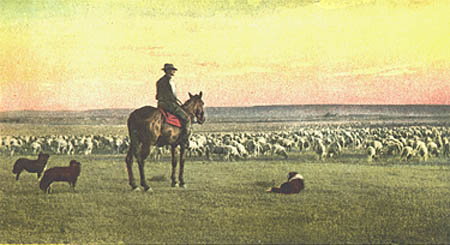
Sheep herding in the West.
[Parts of this article appeared in The Working Border Collie by Marjorie Quarton and Carole L. Presberg,
Part II, "The Border Collie In America: Origins and History of the Breed in America" by Carole L. Presberg.
It has been expanded upon, and will be added to from time to time.]
[Please go to Introduction to the Herding Dogs of North and South America
for a more detailed discussion of the early history of sheep and sheepdogs in America]
Working collies have been imported to America since the beginning of the nation. They were simply called collies or collie dogs. There is a painting of George Washington, bidding farewell to the Marquis de Lafayette at Mount Vernon in 1784, with his family and two dogs. One dog appears to be a spaniel, and the other is a collie that would not be seen as different from any Border Collie today (Presidential Pets by Niall Kelly, Abbeville Press, 1992.)
Starting at the end of the Civil War, wealthy Americans sheep ranchers began to import sheep. Shepherds, sailing to America with their families and collies, were employed to escort the flocks on board the ships and to work on American estates. When the need arose, these shepherds sent home to Britain for the dogs they knew best.
It is difficult to guess what many of these early immigrants may have gone through, sailing to a foreign land aboard ships crowded with people, livestock, and dogs, but one immigrant, albeit arriving at a later date than the shepherds we are speaking of here, wrote a brief description of his family's arrival in Canada:
When our family sailed from Scotland to Canada in 1929, our black and white Border Collie was kept in the hold. After docking in Halifax, we boarded a train without having seen our luggage or dog. The next morning in Montreal, we had to transfer to another station to continue on to Toronto. Because we still hadn't seen our belongings, we questioned the baggage-car crew. To our dismay we were told that a small dog had run off while being transferred to the second train. Just then a porter appeared and announced: 'There's a pile of luggage over on No. 8 platform that might belong to these people. But a little black and white dog is sitting on it and won't let any of us touch it.'" (Eoin P. MacIntyre, Reader's Digest, August 1994)
Recently, I heard from a relative of Mr. Macintyre in Scotland, who said that the date given, 1929, was wrong, and that the true date was in fact 1909. I have written to Reader's Digest in an attempt to check the facts, but have yet to hear from them. This story had a happy ending, but earlier emigatation would have been fraught with greater perils, and the trip would have taken longer.
Left, Border Collies and a mounted cowboy gathering sheep.
From the middle of the 18th century to the beginning of the 20th, America expanded west. Great flocks of sheep and herds of cattle were moved. In the east, there were still large tracts of land being grazed by sheep, cattle, and dairy heards. Often, in both the east and west, herds were driven to higher, greener pastures during summer, and to railroad heads or markets. Livestock was managed, usually by men on horseback, with the help of dogs.
When gold was discovered in California in 1849, prospectors quickly depleted the local food supplies, and meat was needed to supply the gold camps. Sheep ranchers in New Mexico ran many trail drives from Santa Fe to the gold fields until the late 1850s. Accounts of the time say that it took seven mounted cowboys to move 1,000 head of cattle. The same number of sheep could be driven by a single herdsman with one good dog. The dogs used were collies. A well-trained dog on those drives did not bark, except to warn of danger, never left the flock, even to chase rabbits, and might protect the flock from predators if necessary.
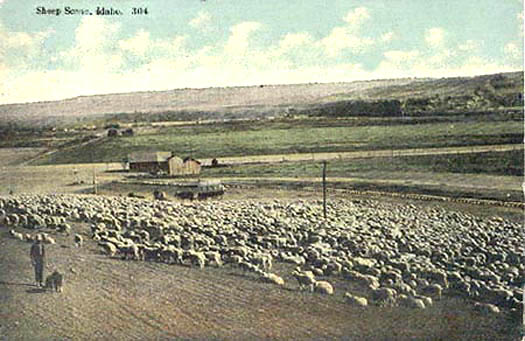 Sheep herding in Idaho. Note the collie in the lower left-hand corner of the picture.
Sheep herding in Idaho. Note the collie in the lower left-hand corner of the picture.
Sheep ranching in many of the western states was started by Scots from the Borders, bringing with them their sheep and collies. Later, when young men left Scotland to come to America, they were sent, often with one or more trained collies, and a letter of introduction, to a Scots sheep rancher--someone who had left Scotland before them and had "made good." Summer pasturage was as it is today--in the high country on public land. Sheep herders worked in summer for food and a wagon to live in and were paid in the fall with choice of land, sheep, or cash, in any combination. Scots that came in the 1890s with only collies thus had the chance to acquire land and sheep. One of these was Idaho rancher, Andy Little, who had been a shepherd in Moffat in the Borders of Scotland. When he was 24 years old, he came to the United States in 1894 with two dogs, Katie and Jim, and a letter to an Idaho rancher.
Ultimately, Little was to maintain 300,000 sheep and over 1,000 fully trained working collies. He returned to Scotland to buy collies and later, his sons made the same visits home. Some of his imports were blue in color and so well liked that other sheep ranchers and herders in the area soon had blue dogs. Little and other Scots ranchers also had a reputation for their ability to train herding dogs. (Andy Little, Idaho Sheep King by Louise Shadduck, Caxton Printers Ltd., Caldwell, Idaho, 1990.)
Eventually, summer shepherding became the work of the Basques, who came to America and worked as contract shepherds, sometimes returning home when they had saved enough money. Often they had no dogs of their own, but instead used the ranchers' dogs. Finally, many Basque also earned land and sheep and began making their mark on America. Dominique Laxalt, the father of a Nevada Governor and United States Senator, was one of them, coming to Nevada at the age of 16 and beginning his herding career with 3,000 sheep and a dog.
Border Collies, descended from these early Western imports, live and work on American ranches today. Many are not registered because their ancestors came here before there was a registry in Britain, but may be as well bred and skilled as the latest imported trial-bred collies.
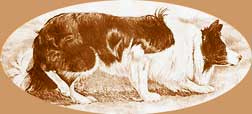
EARLY SHEEPDOG TRIALS IN THE UNITED STATES
In 1880, a herding trial was held in Philadelphia called the "Great International Collie Trial". It is considered by most to be the first sheepdog trial held in the United States. The dogs that competed in it were called simply "collies" or "Scotch collies." Some may have been the earliest show collies [in the United States], somewhat different in looks from the working collie stock from which they developed, but still retaining some herding instincts. Others were simply working collies and may have been the ancestors of old-fashioned farm collies, English Shepherds, and Border Collies in this country. Several Philadelphia newspapers reported on this trial and the dogs that competed in it.
One dog that particularly stood out was "Oscar, [a] large black-and-tan collie." Oscar was bread by a Mr. Steel of Burnhead, Scotland and was reputed to have won "First Prize for penning sheep at the great show at Ayr, Scotland, in 1876." He was imported by T.S. Cooper, a prominent importer of collies. That he still had herding ability was apparent, and one account has it that he wond the trial. Another account mentions that "Tom, [known as the] Philidelphia dog by reason of his long service in driving sheep from the stockyards [in Philidelphia] through the city to the Camden ferries," won the trial for his owner and handler, a drover, Mr. Charles Pugh.
Several other dogs were mentioned--"Lad", a smooth-coated tricolored dog owned by George Taylor of Sheffield, England; "Tweed", owned by Dr. J.W. Downey of New Market, Maryland and worked by a Mr. Phebus; "Fan", a tricolored bitch owned by T. S. Cooper and worked by a shepherd; "Lady Scotland", a tawny-red puppy, only six months old; and so on. What is remarkable about the accounts of this trial, at a time when bench shows were the vogue, is that very little space is taken up describing what dogs look like, so we will never really know for sure. A great deal is made of their working style and ability to handle the sheep.
The course was horseshoe-shaped, about 700 yards long, and tested only driving and penning skills. The handler was allowed to accompany the dog the entire way and could go either in front of or behind the sheep, showing that the working styles of the dogs were expected to be as diverse as their looks. In penning, a dog was permitted to bark.
Accounts of other sheepdog trials began to appear in newspapers before or just at the turn of the century. One was held at the Vermont State Fair in 1908. The contestants described were two sables, a smoo-coated, a black-and-white collie, and a Bearded Collie named Miller's Bruce. Again, emphasis was on working abiilty. "Dash" and "eye" were considered important, as were patience and quiet style. This trial was set up similarly to British trials, with an outrun and fetch, a drive, and finally a pen. The reporter concluded that, "there is every hope that this interesting and instructive work will become popular at the State Fairs and open air shows of the future."
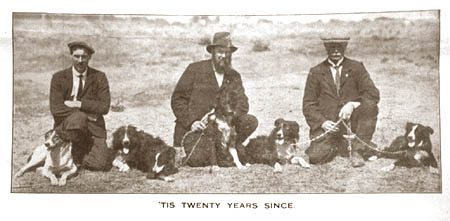
Left is a photo from the ISDS program mentioned below, of the Mr. James Scott of Troneyhill (center), Mr. John Johnstone (left), and Mr. William Robertson (right) and six dogs they brought with them from Scotland.
The following interesting bit of history of the Border Collie in America comes from a 1930 International Sheep Dog Society (I.S.D.S.) program provided by Mrs. Barbara Carpenter of Gloucestershire, England:
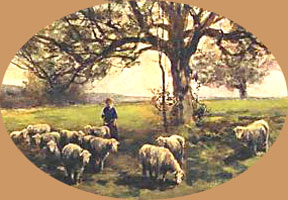 Right, sheep grazing in a field by American artist Frank F. English (1854-1922)
Right, sheep grazing in a field by American artist Frank F. English (1854-1922)
Mr. John Johnstone, 'Ardluing' Largs, who was...Scottish President of the International Sheep Dog Society [from about 1927], has had pastoral connections for many years. In 1910, through his brother who was resident in America and actively associated with [agricultural] shows there, he was requested to send two Scottish shepherds to give exhibitions wih sheep dogs at the State Fairs. He selected Mr. James Scott, then of Troneyhill, Ancrum, Roxburghshire, and Mr. Wm. Robertson, Ballakin, Pirnmill, Arran, and subsequently all three sailed to tour the States with six dogs, Mr. Scott having four and Mr. Robertson two. They were away for three months, and at the close of the tour, which by the way, was handsomely remunerated, five of the dogs were sold by public auction in Dakotah at prices ranging from £15 to £64, the sixth being gifted by Mr. Robertson to a relative. The highest price dog was 'Sweep', a son of Mr. Scottıs famous 'Old Kep'. This, the first visit of the kind to the States, aroused an interest there in the British collie which has grown ever since, many working collies having been exported to America during the last twenty years...
On February 2, 2008 I received an email from James Bruce Scott, a grandson of James Scott of Troneyhill. He confirmed that the gentleman in the middle, above, is indeed his grandfather, James Scott, and said:
My father was born at Trony Hill in 1910, the cottage is to this day a shepherds cottage. As a result of the trip to the USA they then moved to Overhall a Farm he could then afford to rent at Hawick and is now owned and run by my first cousin Wilson Scott. James Scott was the longest serving president of the Scottish sheepdog association and died in 1947 and I can remember him working with his dogs to the end.
Trials did eventually catch on in America. Trials began to be held throughout the country at all the important agricultural fairs, at a variety of livestock events, and at Scottish games. As in Britain, many of the trials in turn spawned local and national associations that then took over organizing annual events. Writing about the importance of sheepdog trials in America, Luke Pasco, a well-known sheepdog handler and breeder from Massachusetts from the 1930s, said,
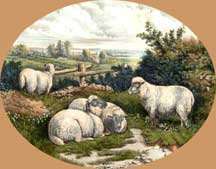 Right, "On The Downs" by American engravers, Currier & Ives (1835-1907)
Right, "On The Downs" by American engravers, Currier & Ives (1835-1907)
Competitive Dog Trials started some eighty years ago andhave really been the making of what the Border Collie is today. It has eliminated all the counterfeits. To this day our trials are perhaps one of the most important angles of the [sheep]dog industry. The course of our trials is such that any dog capable of going the course is likely to be a high class, practical dog for any dondition or type of farm or ranch work." (Heather Jean, The Working Sheep Dog by Luke Pasco, Sheep Breeder Inc., 1937.)
Arthur Allen, another notable Border Collie handler and breeder, attributed the surge of interest in sheepdog trials in the 1920s to an increase in livestock importation and new popularity of livestock shows and state fairs. He said,
[The '20s saw a] new beginning of trials in the U.S., particularly in the Midwest. However, by 1930, the larger trials had shifted to the Eastern states. By 1940, the major trials were ifor the most part in the Midwest and far west. Competition was mostly singles. There were a few outstanding brace teams at the trials and exhibitions in the forties. The last officially sanctioned brace trials were in 1970 and 1971 in Illinois.
In the seventies, trials were well scattered over most of the U.S., hampered greatly by the high cost of travel and distance, along with the major problems of lack of unity and uniform trial rules, and one govening body that could resolve all matter of importance as they do in the British Isles. (A Lifetime With The Working Collie by Authur Allen, 1979.)
Also at odds was the confusing variety of awards presented at different trials. Pasco's Jean, for example, was the "American Outdoor Champion" of 1932 and 1933, and the "American Indoor Champion" in 1933. Titles were spoken of without mention of the trial at which they were won as if they were national titles wond at a trial that culminated the entire season, which was not necessarily the case. However, a number of trials eventually emerged that were univerally accepted as prestigious. Among them were the Far Western International Sheep Dog Trials which ran from 1939 through 1964; the North American Supreme Championship sponsored by the North American Sheep Dog Society (NASDS); the Canadian Open; the Midwest (held at Lodi, Ohio); and the Blue Grass National Open,held at Walnut Hill Farm in Lexington, Kentucky, from the 1960s through 1983.

Above, Luke Pasco and Heather Jean "penning an unruly group of ewes before an audience in the south" in the late 1930s.
(Photo courtesy of Wendy Jones of Cabot, Vermont, whose mother, Ruth Botz Jones, an undergraduate student at the time,
took the photos and submitted them to Wisconsin Country Magazine, published by the University of Wisconsin Agricultural Extension Service.)
AMERICAN BORDER COLLIES
IN THE FIRST THREE QUARTERS OF THE 20TH CENTURY
AND THEIR LEGENDARY HANDLERS
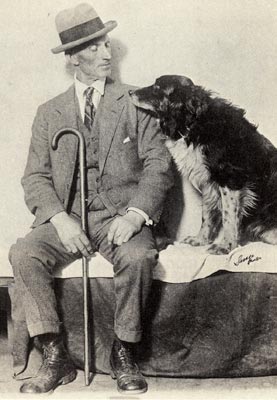 Left, Sam Stoddart and Spot 308. (Photo from A Lifetime With the Working Collie by Arthur Allen, self published 1979.)
Left, Sam Stoddart and Spot 308. (Photo from A Lifetime With the Working Collie by Arthur Allen, self published 1979.)
Registered Border Collies (though they were still called sheepdogs) began being imported into the United States soon after the International Sheep Dog Society (ISDS) was formed in 1906, but the dog considered to be the first significant import was Spot 308. Spot was bred by G.P. Brown of Berwickshire, England, and was born in 1920. He won his first trial in 1921, the International Shepherd's Cup in 1922, and became International Supreme Champion in 1923. He had a tremendous influence on the breed in Britain, Australia and the United States. In 1923, when he was three [years old], he was sold to Sam Stoddart, a Scottish shepherd living and working in the United States. Stoddart was one of the leading breeders of registered Border Collies in America in the 1920s and '30s. He gave sheepdog deomonstrations at agricultural fairs, and many of the early sheepdog handlers were introduced to the breed by seeing him there. He is considered by many to be the founder of the North American Sheep Dog Society (NASDS), and Spot 308 became North American #1 posthumously.
A number of prominent breeders of the time began to perpetuate Spot's influence by breeding his progeny. There followed in the wake of Stoddart and Spot a great deal of interest in sheepdog trialling among sheepmen and agriculturalists in the United States. In order to understand the background of the Border Collie in America, we must consider how very involved in the agricultural industry the major breeders and trialists of this period were. Many of them were farmers, ranchers, hired shepherds, farm managers, or worked in livestock research or education at the agricultural schoos of large universities. This made for someone familiar with breeding and genetics who could complehend the needs of the industry and grasp what traits to look for in a good herding dog. At the same time as Border Collies were being imported from Britain to become the foundation stock of the breed in this country, their American-bred progey were also making their mark.
Just as trials in Britain influenced the breed there, they greatly influence the breed in the United States. And though most successful breeders also did well in trials, some men preferred giving demonstrations at fairs and rodeos, where they could meet farmers and ranchers face to face and promote the breed. Nancy Keller, a Border Collie archivist from Corydon, Indiana, wrote,
"Herding exhibitions were very significant in the development of the Border Collie in the United States after World War I. At that time the skill of using a Border Collie to work sheep was known to very few in this country, mostly hired shepherds or sheep breeders. Sheepdog trials were almost nonexistent, so the only exposure the majority of the public had to the Border collie during that period was through herding demonstrations given at fairs and livestock exhibitions." (The Shepherd's Dogge, March 1989.)
Among the well-known handlers who gave demonstrations at these Agricultural events were Arthur Allen, Luke Pasco, Carl Bradford, Jim Shearer, and others.
If the desired effect was to publicize the breed, the audience reached was even broader for handlers whose Border Collies appeared in motion pictures. It was not at all unusual, and also a very uniquely American approach, for experienced handlers to go to work for movie producers. Walt Disney made a number of films that had Border Collies in them. Charles Null's King, a smooth-coated American-bred dog that won the Far Western International Sheep Dog Trials for seven consecutive years from 1954 to 1960 and was extensively used in exhibitions, appeared in two movies, Wild is the Wind and The Proud Rebel. Another King, AIBC 777 belonging to Clint Harlow of Llano, Texas, also appeared in films.
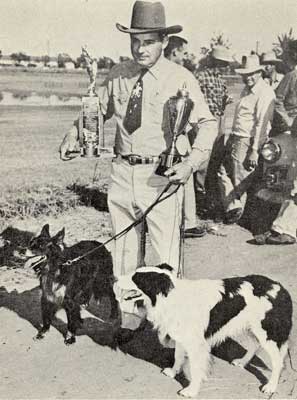 Left, Arthur Allen with Nicky (left) and Spot. (Photo from A Lifetime With the Working Collie by Arthur Allen, self published 1979.)
Left, Arthur Allen with Nicky (left) and Spot. (Photo from A Lifetime With the Working Collie by Arthur Allen, self published 1979.)
Arthur Allen, from McLeansboro, Illinois, became a very well-known sheepdog trialist. His Imported Rock 7222, the 1954 North American Supreme Champion, was a son of Gilchrist's Spot 7320 and granson of Wilson's Moss 5176. Rock appeared in two Walt Disney movies, Border Collies in Action and Arizona Sheep Dog, the latter staring Allen's little black Border Collie, Nickey NA2339, who all by himself shepherds five stray sheep through the Arizona wilderness to rejoin the flock, demonstrating a Border Collie's great skill. Allen's imported dogs won every North American Supreme (the trial sponsored by NASDS from 1954 through 1976, including 21 consecutive years. He imported and bred many Border Collies from outstanding British lines that had a marked effect on the breed in the United States, particularly in the early years.
Jim Shearer from Pennsylvania also worked for Walt Disney. His Tim sired by Imported Rock, is probably the Border Collie that appeared in the Disney film, 101 Tasks of Hercules. Shearer considered Tim his best dog ever and said that when working on a ranch in California that "included 42,000 acres of different terrain and all kinds of situations, [Tim] proved himself an indefatigable worker and companion." As a demonstration of Tim's skill, Shearer mentions "gathering 2,000 wild Santa Barbara sheep for shipping to market."
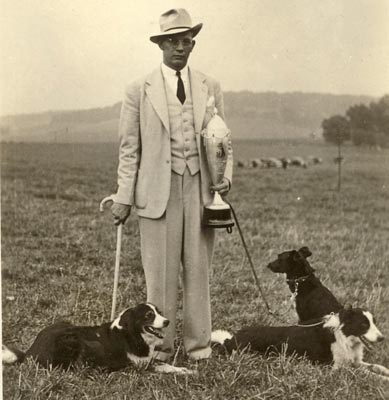 Left, Luke Pasco and Heather Jean (at left) "at completion of winning the 1937 American Championship". We don't know who the other two dogs are. (Photo courtesy of Wendy Jones of Cabot, Vermont, whose mother, Ruth Botz Jones, an undergraduate student at the time, took the photos and submitted them to Wisconsin Country Magazine, published by the University of Wisconsin Agricultural Extension Service.)
Left, Luke Pasco and Heather Jean (at left) "at completion of winning the 1937 American Championship". We don't know who the other two dogs are. (Photo courtesy of Wendy Jones of Cabot, Vermont, whose mother, Ruth Botz Jones, an undergraduate student at the time, took the photos and submitted them to Wisconsin Country Magazine, published by the University of Wisconsin Agricultural Extension Service.)
As the larger-than-life handlers of the first three-quarters of the 20th century began to retire or pass away, a new breed of handler began to take their place. The sheepdog handlers of yesteryear worked in agriculture and used Border Collies to help them in their jobs. Though some of today's trial handlers farm for a living, many are only involved with Border Collies in the sport of trialling. Some keep a few sheep just to train their dogs, some keep no sheep at all but travel to train their dogs. Some are "professional handlers"--they make their living from the Border Collie, breeding and selling puppies, traveling the "sheepdog trials circuit," making their livings from prize money, judging trials, teaching herding and judging clinics, or giving private lessons to would-be handlers.
[There have been many significant Border Collies in America, both imported and American-bred, and American breeders, handlers, and trainers of consequence, that warrent discussion. We hope to present profiles on some of them in the future elsewhere on this website. ]
BORDER COLLIE REGISTRIES IN THE UNITED STATES
Unlike Britain, which has four separate countries competing in sheepdog trials but only one registry for the working Border Collie, the International Sheep Dog Society (ISDS), there have been three registries specifically for Border Collies in the United States: the North American Sheep Dog Society (NASDS), which is the oldest; the American International Border Collie Registry (AIBC); and the American Border Collie Association, Inc. (ABCA), which is the most recently formed of the three, and effectively the only one still registering dogs.
Below, sheep by Alfred Morris (1871)
 North American Sheep Dog Society (NASDS)
North American Sheep Dog Society (NASDS)
Prior to World War II, American Border Collies were registered with ISDS in Britain. James Reid, secretary of ISDS for more than 32 years, beginning in 1913, was also instrumental in formaing NASDS and guiding its early years. Founded in 1940, NASDS had among its charter members, or those joining it while it was still in the fledgling stage, Sam Stoddart, Luke Pasco, Carl Bradford Sr., Carroll Shaffner, Arthur Allen, and other prominent American sheepdog handlers of the day. Dr. Donald Bell of Wooster, Ohio, became the first secretary, and in 1942, NASDS or "the North American, " as it was commonly known, began registering American dogs. Many of the dogs of the day were imported along with their ISDS registration numbers, and then were also registered by NASDS. Sam Stoddart's Spot 308 posthumously became NA 1, and, as was the custom, would have appeared in pedigrees as "Stoddart's Imp. Spot 1 (308)." Arthur Allen became president in 1951 and remained at the helm until his death in 1997. NASDS sponsored the North American Supreme Championship Trials, which were held every year.
Below, "Agriculture Plate VIII: Leicester Ewes", artist/author unknown.
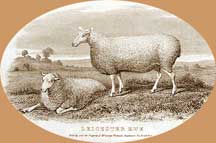 American International Border Collie Registry (AIBC)
American International Border Collie Registry (AIBC)
In 1951, a disagreement arose among the prominent members of NASDS and certain of them were ousted from leadership roles. These men formed the Iowa Border Collie Association, from which the AIBC registry developed in 1952. Olive Downs of Ames, Iowa was the first secretary, her husband, Millard E. Downs, was the first treasurer, and Dewey Jontz was the first president.
AIBC was incorporated in Iowa and, like NASDS before it, became an affiliate member of ISDS. The reason it was called "American International" and not just "American" was two-fold: first, the founders wanted to indicate their affiliation with ISDS, and second, the name "American Border Collie" was taken at the time by Ohio Border Collie breeder Howard McClain for a private registry for dogs of his own breeding, known as ABC or simply "McClain's." Other private registries also existed at the time, including "Topliff's" and "Perrot's", which was called the Border Collie Registry Bureau and would have appeard on pedigrees as BCRB. Eventually, these became absorbed by AIBC. There were also numerous desertions from NASDS to AIBC, the most notable being the mass defection in 1958 of Ray Parker and thirty other Border Collie breeders from Texas.
Olive Downs remained the secretary of AIBC until her retirement in 1964, when Ara Jontz, the wife of Dewey, took over. She did not remain secretary long, however, as she became ill and subsequently passed away, and the stud book passed to Jack Kaster in 1966. Jack Kaster maintained the stud book until about the mid-'80s, when it was passed to Sennette Parker of Chappell Hills, Texas, widow of the late Clifford Parker, a well-known handler.
Below, "Agriculture Plate VIII: Leicester Rams"
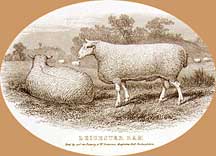 American Border Collie Association, Inc. (ABCA)
American Border Collie Association, Inc. (ABCA)
In 1983, a group of about twenty sheepdog trial handlers met in Starkville, Mississippi, and started a third Border Collie registry, the ABCA. It, too, became affiliate of ISDS. (Foreign registries wishing to become associated with ISDS pay an "affiliation fee". ISDS considers such a collaboration to forge "a closer bond" and enables the organizations to "work more closely together for the benefit of the Border Collie." (Philip Hendry, then secretary of ISDS, in a letter to ABCA on 28 January 1983.)) Ralph Pulfer of Quincy, Ohio, was the first president of ABCA, followed by Herbert Holmes of Sheffield, Texas.
Today, ABCA is the most active American Border Collie registry and registers the most dogs. In effect, it is the only one still functioning. It accepts registration from ISDS and the other two American registries, as well as registration from the Canadian Border Collie Registry (CBCA). The president is Jim Swift of Grand Junction, Colorado, and Patty Rogers of Perkinston, Mississippi, is secretary-treasurer, and has been since the beginning.
Below, "A Joyless Winter Day" by Joseph Farquharson (1846-1935).
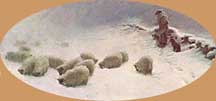 United States Border Collie Handlers Association (USBCHA)
United States Border Collie Handlers Association (USBCHA)
One other organization must be considered here, and that is the USBCHA. This is not a registry, but a handler's association that has become and considers itself "the sanctioning body for sheep and cattledog trials throughout the United States and Canada. It was founded in 1979 and has grown into an organization of more than 800 members. Members who qualify at sanctioned Open trials during the year are eligible to compete in the USBCHA National Sheep and Cattle Dog Finals to determine the [National] Champion Open Dog and Handler for that year." Herbert Holmes of Sanderson, Texas, is president, and Francis Raley of Crawford, Texas, is the secretary/treasurer.
There has never been a lull in the importation of top trials dogs or their progeny from Britain, but literally thousands of American-bred dogs are registered every year. Keep in mind that there is probably an equal number that are not registered with any working sheepdog registry. Other registries also register the Border Collie, including the American Kennel Club (AKC) which registers dogs for conformation. On many farms and ranches, there are working dogs that are not necessarily registered at all.
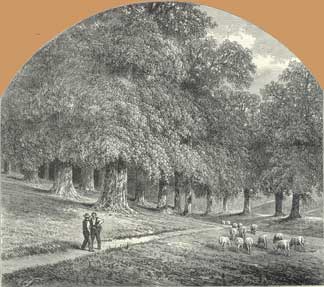
Above, sheep grazing in
Druid Hill Park in Baltimore.
SHEEP GRAZING IN PUBLIC PARKS IN THE USA
Left, sheep grazing in Franklin Park, Boston, ca. 1905.
All the large urban parks, including Central Park in New York City, had sheep grazing them at one time or another. It was the only way to manage large, open grassy areas so that they remained open for recreational purposes. This practice is reflected in the names of some areas of these parks that still exist today, such as "the Sheep Meadow". If you look closely in this photo, you can see that people shared the space with the sheep. In the background there are people strolling in the park, people sitting under the trees, and a man walking out among the sheep toward the left side of the photo. It is likely that a herding dog was used to manage these sheep, though there is none in this photo.
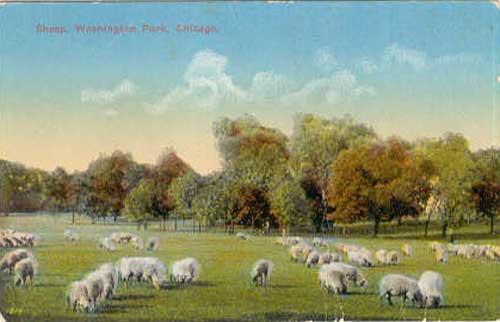 Left, sheep grazing in Washington Park, Chicago.
Left, sheep grazing in Washington Park, Chicago.
Druid Hill Park in Baltimore, Maryland, was among the vanguard of great urban parks in the United States. In 1860, the Baltimore Park Commission purchased the Druid Hill estate. The estate had been laid-out in the manner of an English garden; the park contained miles of carriage and bridle paths, a lake, and picnic groves. The designers made every attempt to utilize the natural terrain with minimal intrusion, and the greens were kept cropped by sheep grazing.
[For a more detailed discussion on the parks in the USA that provided grazing for sheep
see Linda Rorem's article "Shepherds of Manhatten" on her Herding on the Web website.]
Three other collie breeds developed in the United States from similar stock of old working collies from Britain. They are the Australian Shepherd, the English Shepherd, and the McNab. In looks it is often difficult to tell these three breeds apart from each other and the Border Collie from old photographs, which is why we are aiming toward labelling our old photos as pictures of shepherd's dogs, rather than as of Border Collies. To find out more about these breeds and the other collie breeds, please visit Border Collie Cousins.
Copyright © 2014 by Carole L. Presberg
[As we are primarily interested in the history of the breed, we do not follow much of what is happening today in the sheepdog world.
If anyone wishes to submit an article to this website on today's dogs and handlers, or on sheepdog trials, we will give it every consideration. --ed.]
THE OTHER WEB PAGES WE MAINTAIN
These web pages are copyright ©2014
and maintained by webmeistress Carole Presberg
with technical help from webwizard David Presberg
ALL RIGHTS RESERVED
If you are interested in using ANY material on this website, you MUST first ask for permission.